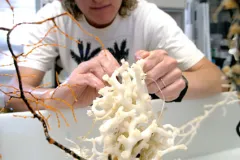Martha Nizinski: Hooked on Deep-Sea Corals

Nine years ago I was invited by a colleague to join a research team investigating deep-sea coral habitats. I was asked to examine the invertebrates associated with these ecosystems. After my first look, I was hooked! I was fascinated by the sheer beauty and complexity of these deep-sea environments. The diversity of species as well as their shapes, sizes, and colors are truly amazing.
The deep-sea corals that provide the structure of these habitats, and the invertebrates and fishes that use the structure, are all connected. We are still learning exactly how. As an ocean scientist and marine biologist, I am interested in exploring unknown or poorly-known ocean habitats, in discovering new or rare species, and in learning how animals and communities function in the deep sea.
Truly an Adventure
Submersibles and remotely-operated vehicles (ROV) enable us to observe deep-sea coral habitats and the animals associated with them firsthand. Every trip in a manned submersible is truly an adventure. I know that I am visiting a place no one else has visited and that I am probably observing something that no one else has seen before. I am a true explorer!
Back in the laboratory, I identify the organisms we collect, study their form and structure, and analyze video footage. I would like to compare the organisms associated with deep-sea coral habitats from different oceans. Are these ecosystems structured similarly throughout the world? I hope to find out.

